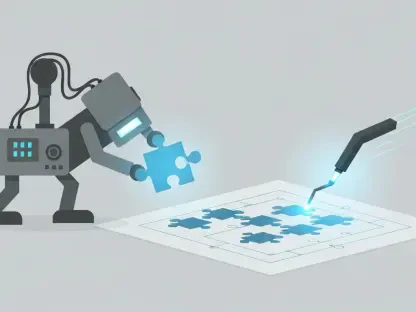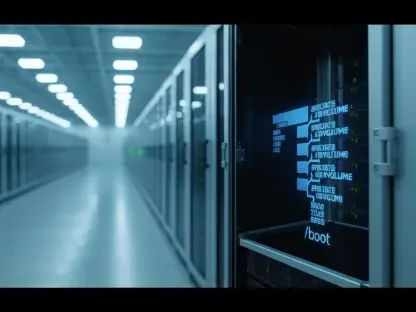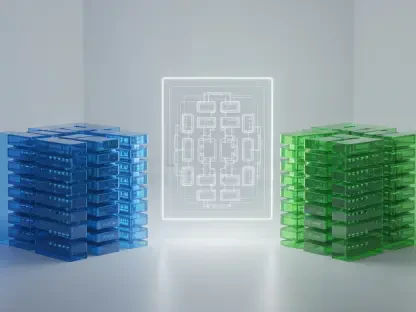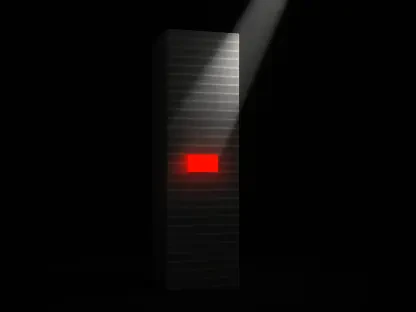Creating and maintaining lightweight Docker images is crucial for efficient application deployment and resource management. Docker images can easily become bloated with unnecessary dependencies, leading to longer build times, increased storage usage, and slower performance. This article explores various strategies to create and maintain minimal Docker images without sacrificing functionality.
Start from Scratch
The Basics of Scratch Images
Starting with a scratch image provides a blank canvas, allowing complete customization of the Docker image. This approach is ideal for applications with minimal runtime dependencies, such as a single binary without linked libraries. When beginning with a scratch image, developers have the advantage of controlling every aspect of the environment, eliminating any superfluous components that would otherwise contribute to image bloat. This meticulous control ensures that only the essential elements needed for the application to run are included, fostering a truly minimalistic image.
However, while starting from scratch offers unprecedented control, it places the onus on developers to ensure all necessary dependencies are explicitly included. It is not enough to simply assume that a minimalist configuration will suffice. Comprehensive checks must be conducted to verify that all linked libraries, certificates, and essential components are present. The challenge lies in striking a balance between minimalism and functionality, ensuring that the image remains lean without compromising the application’s operational requirements. Failure to include these dependencies can lead to a non-functional application, highlighting the importance of thorough verification.
Verifying Dependencies
When using a scratch image, developers must ensure that all runtime dependencies are explicitly included. This includes linked libraries, certificates, and other essential components. A meticulous audit of these requirements can prevent runtime errors and operational failures, safeguarding the application’s integrity. This audit process involves rigorously testing the application in the scratch environment, identifying any missing dependencies, and including them in the final image. Such vigilant scrutiny guarantees that the application functions correctly, even within a stripped-down container.
To streamline the verification process, developers can leverage tools and scripts that automate dependency checks. By integrating these tools into the build pipeline, teams can achieve a higher degree of confidence that all necessary elements are incorporated. Furthermore, documenting these dependencies and their inclusion process ensures that future builds remain consistent and reliable. This step-by-step verification not only maintains the lightweight nature of the image but also reinforces best practices in Docker image creation, aligning with the overarching goal of producing efficient, functional, and minimalistic containers.
Use a ‘Slim’ Runtime Image
Benefits of Slim Runtime Images
Slim runtime images are prebuilt with only the necessary components to support the application’s language runtime, such as Python or Node.js. These images reduce the base size, making them an excellent starting point for creating lightweight Docker images. By leveraging slim runtime images, developers can capitalize on a tailored environment that includes only the most essential elements. This approach significantly reduces the image size, which translates to quicker build times and lower storage costs, ultimately enhancing overall efficiency.
Additionally, slim runtime images offer a streamlined foundation that still retains the necessary components to run language-specific applications effectively. This selective inclusion approach makes it easier for developers to build upon a minimal base, adding only what is required for their application’s unique needs. Utilizing these images can also lead to improved performance, as the reduced bloat means fewer resources are required to run the container. This focus on essentiality aligns with the principles of efficiency and optimization in modern software development practices.
Adding Application-Specific Dependencies
While slim images provide a smaller base, developers must still add application-specific dependencies during the build process. This ensures that the final image contains all necessary components for the application to run smoothly. It involves a thorough understanding of the application’s requirements and meticulously incorporating each dependency. By doing so, developers can maintain the lean nature of the image while ensuring comprehensive functionality.
To achieve this balance, developers should adopt practices like modularizing dependencies and explicitly listing them in the Dockerfile. This practice aids in tracking and managing dependencies efficiently, preventing unnecessary additions to the image. Moreover, conducting periodic reviews of the dependencies can help identify and remove any redundant elements, further refining the image. This continuous attention to maintaining a minimalist yet fully functional image underscores the importance of meticulous dependency management, ensuring that only the required elements are included without sacrificing performance or resource efficiency.
Google Distroless Images
Introduction to Distroless Images
Google’s Distroless images are optimized, stripped-down Debian instances that support multiple languages, including Python, Java, and Node.js. These images do not include shells or package managers, resulting in a minimalistic footprint. By eliminating these non-essential components, Distroless images provide a highly optimized environment tailored specifically for running applications. This approach ensures that the image remains as light as possible, reducing overhead and streamlining operations.
The appeal of Distroless images lies in their security and efficiency. Without unnecessary components like shells or package managers, the attack surface is minimized, enhancing the container’s security profile. Additionally, the smaller size means faster deployment times and reduced storage requirements. However, this optimization requires a more thoughtful configuration, as the absence of a shell necessitates precise setup within the Dockerfile. Understanding how to effectively utilize Distroless images involves mastering these configurations to leverage their full potential while maintaining simplicity and security.
Configuring ENTRYPOINT
Due to the absence of shells in Distroless images, developers must configure the ENTRYPOINT in the Dockerfile accurately. This ensures that the application runs correctly without relying on a shell environment, maintaining the image’s minimalistic nature. Configuring ENTRYPOINT properly is critical, as it dictates how the main process of the container starts and operates. In Distroless images, this configuration must be precise, specifying exact commands and parameters without assuming the presence of a shell to interpret them.
This precision demands a thorough understanding of the application’s startup requirements and behaviors. Developers must diligently test different configurations to identify the optimal setup that ensures smooth operation. Additionally, documenting these configurations can aid in maintaining consistency across different builds and facilitating troubleshooting. By mastering ENTRYPOINT configurations, developers can fully realize the benefits of Distroless images, achieving a lean, secure, and efficient container that aligns with best practices in Docker image management.
Multi-Stage Builds
Concept of Multi-Stage Builds
Multi-stage builds use multiple FROM statements within a Dockerfile to create layered builds. This approach allows developers to segregate the build process into stages, reducing unnecessary artifacts by copying only essential elements into the final image. Each stage in a multi-stage build performs a specific function, such as compiling code, installing dependencies, or conducting tests, before passing only the necessary components to the next stage. This method provides a clean and efficient way to manage the build process, ultimately resulting in a lightweight final image.
The sophistication of multi-stage builds lies in their ability to isolate different aspects of the build process, minimizing clutter and reducing the risk of including unnecessary elements. By segmenting the process, developers can ensure that only the essential files and dependencies make it into the final image, conserving storage space and improving performance. This modularity also enhances the reproducibility of builds, making it easier to pinpoint and resolve issues at specific stages without affecting the overall process. Mastering multi-stage builds can lead to significant gains in efficiency and maintainability, aligning with the goals of creating streamlined and effective Docker images.
Advantages of Multi-Stage Builds
By separating the build process into stages, multi-stage builds enhance dependency management and reduce the final image size. This method also allows for the reusability of stages, making it easier to manage dependencies and outputs efficiently. For instance, a base stage might handle the installation of core dependencies, which can then be reused across multiple builds or projects, thereby saving time and ensuring consistency. This reuse minimizes redundancy and streamlines the build process, contributing to overall stability and efficiency.
Moreover, multi-stage builds offer enhanced control over each build phase, allowing developers to fine-tune and optimize individual components. This control facilitates cleaner and more organized Dockerfiles, which are easier to read, maintain, and troubleshoot. Additionally, this approach can significantly reduce the number of layers in the final image, leading to a leaner and more performant container. The strategic use of multi-stage builds thus represents a powerful technique for creating optimized and maintainable Docker images, emphasizing both efficiency and functionality.
Minimize Layers
Consolidating RUN Commands
Minimizing the number of layers in a Docker image is crucial for reducing its size. Consolidating RUN commands within Dockerfiles helps achieve this by combining multiple commands into a single layer. Each RUN command in a Dockerfile creates a new layer, so by grouping commands together, developers can significantly decrease the total number of layers. This consolidation not only reduces the image size but also enhances build efficiency, as fewer layers mean fewer steps for the Docker engine to process.
To effectively consolidate RUN commands, developers should strategically organize their Dockerfiles, combining related commands wherever possible. This might involve grouping package installations, configuration adjustments, and cleanup commands into single RUN instructions. Such optimization practices also reduce the overhead associated with creating numerous intermediate layers, further streamlining the image. A well-structured Dockerfile that consolidates RUN commands can lead to more manageable, efficient builds, resulting in cleaner and more performant Docker images.
Tools for Layer Minimization
Third-party tools like docker-squash can merge layers, further reducing the image size. Additionally, the multi-stage build process can refine the contents into a new container, ensuring a leaner final image. Docker-squash, for instance, simplifies the image by combining multiple layers into one, effectively reducing the overall layer count. This tool is particularly useful for post-build optimization, ensuring that the final image is as streamlined as possible without altering the original build process.
Another powerful technique involves leveraging multi-stage builds to reduce layers. By carefully designing the stages, developers can eliminate temporary or intermediary layers, moving only the necessary components to the final stage. This approach not only reduces the number of layers but also minimizes dependencies and potential points of failure. Integrating these tools and techniques within the build pipeline offers a robust strategy for achieving minimal and efficient Docker images. Through such practices, developers can ensure that their images are lean, maintainable, and optimized for performance, aligning with best practices in modern containerization.
Use .dockerignore
Purpose of .dockerignore
The .dockerignore file is used to exclude irrelevant files and directories from the build process, keeping the Docker image clean. This prevents unnecessary bloat caused by including temporary files, build artifacts, or unrelated directories. By specifying which files and directories to ignore, developers can maintain a focused and efficient build context, ensuring that only essential components are included in the final image. This practice is particularly beneficial in large projects where numerous temporary or auxiliary files might otherwise clutter the build environment.
Using the .dockerignore file effectively requires careful consideration of the project structure and build requirements. Similar to the .gitignore file used in Git repositories, .dockerignore allows granular control over the exclusions, enabling developers to tailor the build context to their specific needs. Properly configured, it can significantly reduce the image size and improve build performance by eliminating unnecessary data. This results in a leaner, more efficient Docker image that aligns with the principles of simplicity and optimization, critical for effective container management and deployment.
Granular Control Over Exclusions
Using .dockerignore allows for granular control over exclusions, similar to the .gitignore file in Git. Developers can programmatically generate .dockerignore files for complex setups, ensuring that only essential files are included in the build. This level of control is invaluable for maintaining a clean and efficient build environment, as it prevents unwanted files from creeping into the Docker image. By automating the generation of .dockerignore files, teams can adapt quickly to changes in the project structure, ensuring that the exclusions remain relevant and up-to-date.
Furthermore, adopting best practices for configuring .dockerignore files involves periodically reviewing and updating the exclusions list. This iterative process helps identify any new temporary or unnecessary files that should be excluded from the build context. Additionally, organizing and documenting the .dockerignore setup can enhance collaboration among team members, providing a clear and understandable framework for managing build exclusions. Through such meticulous management, developers can maintain a streamlined and optimized build process, resulting in cleaner, more efficient Docker images that are easier to maintain and deploy.
Inspection and Minification Tools
Dive Tool for Analysis
The dive tool helps analyze Docker images layer by layer, identifying changes and areas of inefficiency. This tool provides insights into the image structure, allowing developers to target specific areas for optimization. By offering a detailed view of how each layer contributes to the overall image, dive enables developers to pinpoint exact sources of bloat and redundancy. This granular visibility is crucial for making informed decisions on how to streamline and optimize the Docker image, ensuring that only necessary components are retained.
Using dive, developers can conduct thorough audits of their Docker images, examining the impact of each layer and identifying opportunities for consolidation. The tool’s interactive interface also assists in visualizing the image structure, making it easier to understand the relationship between different layers and their contents. This detailed analysis fosters a deeper understanding of the build process, empowering developers to optimize their Dockerfiles more effectively. By integrating dive into the development workflow, teams can achieve more efficient, leaner Docker images, aligning with the goals of performance and minimalism in containerized applications.
Slim Tool for Minification
The Slim tool helps reduce Docker image sizes by stripping away unnecessary components while retaining the necessary elements for the application to function correctly. This process involves assessing each layer of the Docker image and identifying any redundant components or dependencies that can be safely removed. Utilizing Slim can lead to significant reductions in image size, which in turn improves build times and overall performance. Furthermore, the streamlined images are easier to manage, deploy, and secure, as they contain fewer components and potential vulnerabilities.
Implementing tools like Slim in the development workflow helps maintain a consistent focus on image optimization. By routinely minifying Docker images, teams ensure that their containers remain efficient and resource-conscious. This practice aligns with broader containerization strategies aimed at enhancing performance, scalability, and security. Through regular use of tools like Slim, developers can achieve lightweight Docker images that support agile and efficient application deployment, fostering a robust and streamlined environment for modern software development.









